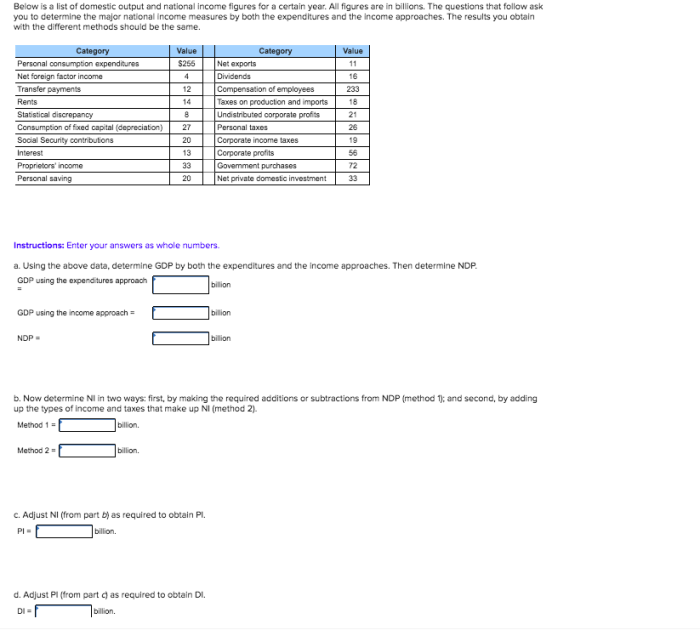Below is a list of domestic output and national income, this topic delves into the fundamental concepts of domestic output and national income, exploring their relationship and significance in economic analysis. Domestic output, commonly measured through GDP (Gross Domestic Product) or GNP (Gross National Product), represents the total value of goods and services produced within a country’s borders.
National income, on the other hand, measures the total income earned by residents of a country, regardless of where the production occurs. Understanding these concepts is crucial for assessing a country’s economic performance and formulating informed policies.
This Artikel provides a comprehensive overview of domestic output and national income, encompassing their basic concepts, influencing factors, accounting methods, and applications. By examining these aspects, we gain valuable insights into the dynamics of economic growth and development.
Domestic Output and National Income: Basic Concepts
Domestic output and national income are key measures of economic activity and well-being. Domestic output refers to the value of all goods and services produced within a country’s borders during a specific period, typically a year or a quarter. It is measured using three main indicators: gross domestic product (GDP), gross national product (GNP), and net national product (NNP).
National income, on the other hand, measures the total income earned by all residents of a country from all sources, including wages, salaries, profits, and interest. It is closely related to domestic output but differs in that it excludes income earned by non-residents and includes income earned by residents abroad.
Domestic output and national income are typically measured using national income accounting, a system of standardized methods and definitions for calculating these economic indicators. These methods include the value-added approach, the income approach, and the expenditure approach.
Factors Affecting Domestic Output and National Income

Numerous factors influence domestic output and national income, including:
- Consumption:The spending by households on goods and services.
- Investment:The spending by businesses on new capital goods and inventories.
- Government spending:The spending by government on goods, services, and transfers.
- Net exports:The difference between exports and imports.
Other factors that can affect domestic output and national income include technological progress, population growth, and international trade.
Domestic Output and National Income Accounting

National income accounting is a set of standardized methods and definitions used to calculate domestic output and national income. The main methods are:
- Value-added approach:Measures the value added at each stage of production.
- Income approach:Measures the income earned by all factors of production.
- Expenditure approach:Measures the total spending on goods and services in the economy.
The following table illustrates the components of the national income and product accounts:
| Component | Definition |
|---|---|
| Gross Domestic Product (GDP) | Total value of goods and services produced within a country’s borders |
| Net Domestic Product (NDP) | GDP minus depreciation |
| National Income (NI) | NDP minus indirect business taxes plus subsidies |
| Personal Income (PI) | NI minus corporate profits, social insurance contributions, and other taxes |
| Disposable Personal Income (DPI) | PI minus personal taxes |
Applications of Domestic Output and National Income Data: Below Is A List Of Domestic Output And National Income

Domestic output and national income data are used in a variety of economic analyses, including:
- Measuring economic growth:Tracking changes in GDP over time.
- Forecasting economic trends:Using past data to predict future economic activity.
- Informing policy decisions:Using data to evaluate the effectiveness of economic policies.
- Comparing economic performance:Comparing domestic output and national income across countries.
However, it is important to note that domestic output and national income data have some limitations, such as:
- Exclusion of non-market activities:Data does not capture the value of unpaid work or leisure.
- Difficulty in measuring quality:Data does not reflect changes in the quality of goods and services.
- Potential for manipulation:Governments may have incentives to manipulate data for political or economic reasons.
Answers to Common Questions
What is the difference between domestic output and national income?
Domestic output measures the total value of goods and services produced within a country’s borders, while national income measures the total income earned by residents of a country, regardless of where the production occurs.
How is domestic output measured?
Domestic output is typically measured through GDP (Gross Domestic Product) or GNP (Gross National Product). GDP measures the total value of goods and services produced within a country’s borders, while GNP measures the total value of goods and services produced by residents of a country, regardless of where the production occurs.
What are the key factors that influence domestic output and national income?
The key factors that influence domestic output and national income include consumption, investment, government spending, and net exports. Consumption refers to spending by households on goods and services, investment refers to spending by businesses on new capital, government spending refers to spending by the government on goods and services, and net exports refer to the difference between a country’s exports and imports.
